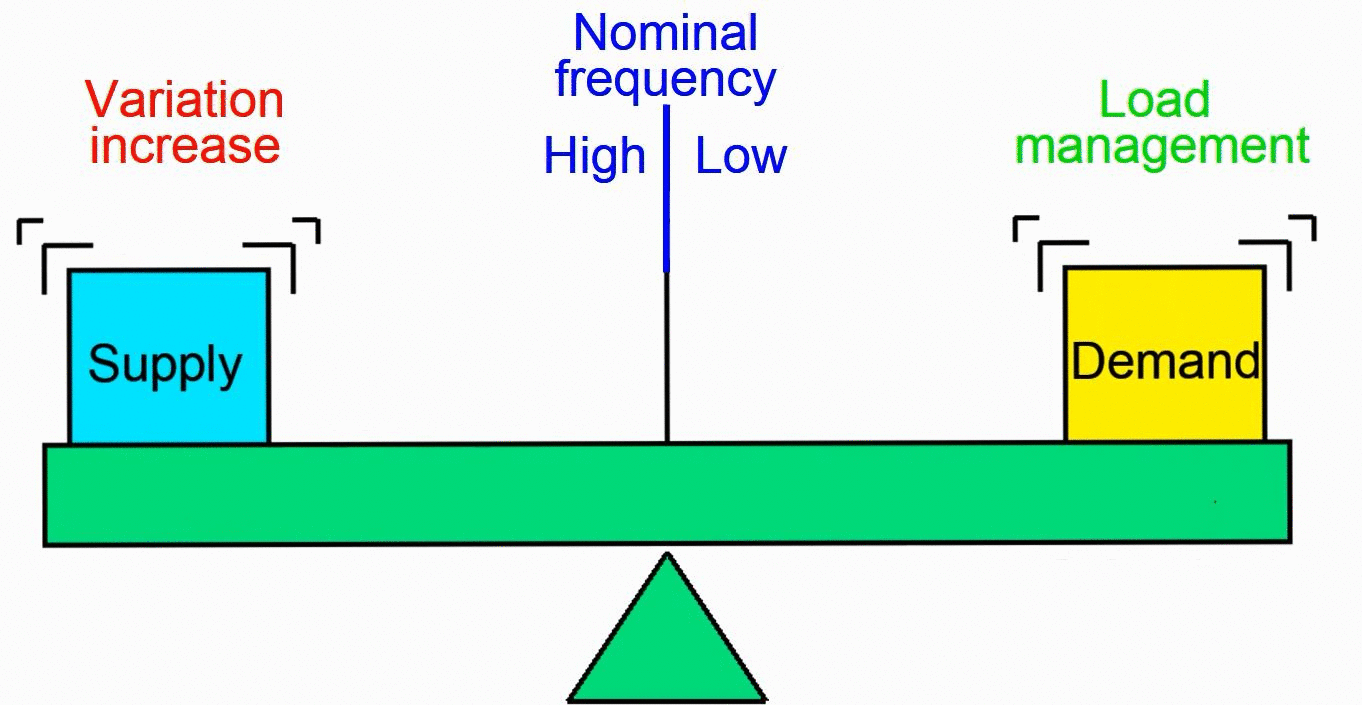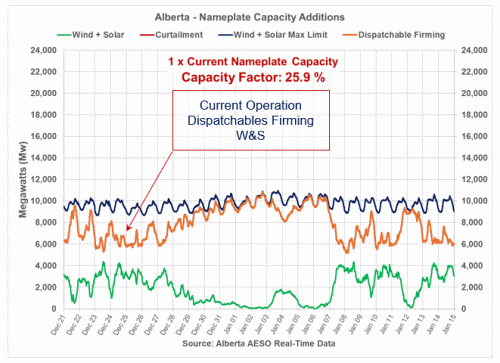Wind and Solar - Part-Time Generators
Highly Variable, Unreliable, Unpredictable, and Uncontrollable Parasites on the Grid
Wind and Solar: Intermittent, Unreliable, Uncontrollable & Part-Time
The electrical grid operates in real time, requiring a precise, second-by-second balance between supply and demand. If this delicate equilibrium is disrupted, blackouts or even a complete grid failure can occur within minutes.
Generation that can load follow are known as being dispatchable.
VRE Generation (Figure 2 - wind and solar) are NOT dispatchable and therefore incapable of load following. They are unreliable, unpredictable, uncontrollable and therefore not Fit-for-Purpose.
To deliver power to the grid, wind and solar output must be adjusted to match demand, as shown in Figure 3.
Two primary methods achieve this:
Default Method: Firming with Dispatchable Sources
Existing coal or gas plants are used to compensate for fluctuations in wind and solar output. Known as "firming" or "back-up," this approach is the most cost-effective, leveraging existing infrastructure without requiring significant new investments.Alternative: Energy Storage
Options include pumped hydro, liquid air storage, hydrogen, or battery energy storage systems (BESS). Renewable energy (RE) advocates often promote storage for firming or back-up, but they frequently overlook the immense capacity required, the substantial capital costs, and the ongoing operational expenses. These factors are explored further in Wind / Solar - The Full Cost of Electricity (FCOE).
Currently, BESS is the most practical storage option, though it comes with notable drawbacks:
Reliability: Curtailed wind and solar is erratic and unreliable.
Capacity Challenges: BESS must have significant capacity to meet year-round demand. Due to seasonal variations in wind and solar generation, many BESS installations may sit idle for much of the year.
High Capital Costs: Unlike coal or gas firming, which uses existing plants, BESS demands substantial upfront investment.
Additional Infrastructure: Extra wind or solar capacity is needed to charge BESS. However, the intermittent nature of these sources often leads to curtailment—wasted energy that increases overall costs.
Cost of Curtailed Wind and Solar: Contrary to what many assume, curtailed wind and solar is not free. Either the user pays for it directly, or the cost is added to consumers utility bills.
Increased Consumer Cost: Energy storage always results in higher consumer costs. To pay variable/fixed costs and ensure a return on investment, it must sell back to the grid at a higher price, typically up-charging between $100/Mwh and $200/Mwh or more.
More Expensive than Dispatchable Sources: Energy storage is more expensive than natural gas, coal or hydro. Adding storage to a grid reduces the capacity factor of dispatchable generators resulting in increased costs, again passed onto consumers
Dispatchable vs Variable Renewable Energy (VRE)
A fundamental distinction exists between dispatchable generation and variable renewable energy (VRE).
Dispatchable generation—such as natural gas, coal, hydro, and nuclear—can operate in two modes:
Baseload Mode (Isochronous): Output is maintained at a constant rate, but can be adjusted as needed to match shifts in demand.
Load-Following Mode (Droop): Output dynamically adjusts to track fluctuations in demand.
Wind and Solar: Parasites on the grid
Wind and solar are prioritized on the grid, not because of a low Levelized Cost of Electricity (LCOE), but due to political pressure aimed at achieving Net Zero goals, often with limited practical impact.
Their intermittent nature forces dispatchable generation—like coal, gas, or hydro—to adjust output to compensate for fluctuations in wind and solar production. This displacement reduces the capacity factors of dispatchable sources, leading to lower energy sales and decreased electricity prices for consumers. For a deeper analysis, see my SubStack article: Wind / Solar - The Full Cost of Electricity (FCOE).
Availability Factor: Not the same as dispatchable generators
A key difference between dispatchable generation and VRE is the Availability Factor (AF). This is not the same as Capacity Factor (CF).
Dispatchable Generation:
With a fleet (multiple facilities) of dispatchable generation, there is a well defined AF, typically ~ 90%.
This includes a contingency reserve (CR) that accommodates unplanned increases in momentary demand.
AF is critical in planning for forecast demand. Because it does not use all potential capacity, it allows for both planned and unplanned outages. This results in a robust and reliable source of power.
VRE:
Because it cannot be controlled, VRE effectively has no defined availability factor.
VRE output is based on probability. At any given moment in time, the output is a function of probability.
Variable Renewable Energy (VRE) Output Probability
Variable renewable energy (VRE) is uncontrollable and cannot operate in baseload or load-following modes. Its output at any moment depends on probability.
As shown in Figure 4, there’s a 31.5% chance that wind and solar will achieve a capacity factor of 55.3%. The only exception occurs when VRE units are manually shut down due to transmission or demand constraints, a process known as curtailment.
Curtailment
As more variable renewable energy (VRE) nameplate capacity is added to the grid, curtailment—reducing net generation—becomes necessary. This can stem from transmission or distribution constraints, or from supply exceeding demand.
Another key factor is the need to maintain a minimum level of dispatchable generation, typically 5% to 10% of demand. This controllable output is essential to balance ever-changing demand with supply. Without it, blackouts or even total grid collapse would occur almost instantly.
Figure 5 illustrates the effects of increasing wind and solar nameplate capacity:
2x Current Capacity: Dispatchable generation decreases slightly.
3x Current Capacity: Dispatchables show minimal further reduction, with peak levels unchanged. Curtailment begins to appear.
4x Current Capacity: Dispatchable generation drops modestly, but peak rates hold steady. No dispatchable units can be deactivated.
5x Current Capacity: Curtailment becomes significant. Dispatchable generation decreases again, though peak rates remain constant.
Curtailment drives the diminishing returns of adding VRE capacity. For more details, see: Wind / Solar and the Effect of Diminishing Returns.
The Myth of “It’s Always Windy or Sunny Somewhere”
Proponents of wind and solar often counter their variability and unreliability with the claim that “it’s always windy or sunny somewhere.” However, real-time data aggregating wind and solar output across wide regions (Figure 6) reveals this to be a misconception.
Even if sufficient wind and solar resources existed over a broad area, meeting demand would require duplicating capacity and building extensive transmission and distribution infrastructure to deliver power to all regions. The costs of such a system would be impractical and exorbitant.










Important information without quite getting to the root of the issue. Due to wind droughts and lack of grid-scale storage, windpower will never work, so get it off the grid!
In Britain after the war people would say “don’t mention the war” because it would upset their German friends.
Now it seems the unspoken watchword is “don’t mention wind droughts.”
They were discovered in Australia round about 2010 and it is most unfortunate that it was too late to avert the rush to wind power which has turned out to be one of the biggest public policy blunders in recorded history.
Trillions of dollars have been spent worldwide to get more expensive and less reliable power with massive environmental impact.
Sailors and wind millers would have known about the prolonged Dunkelflautes for centuries but the meteorologists have apparently been under instruction from the parent body not to issue wind drought warnings.
The WMO is located at the heart of the climate alarm industry in the UN and they know all about wind droughts because the first assessment report from the IPCC in 1990 recommended a survey of the world’s wind resources to see the prospects for large-scale wind power.
We really have to talk about wind droughts.
https://open.substack.com/pub/rafechampion/p/we-have-to-talk-about-wind-droughts